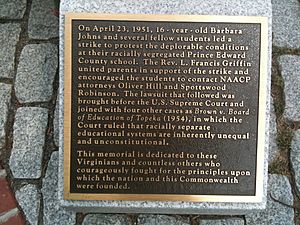Virginia Civil Rights Memorial facts for kids
The Virginia Civil Rights Memorial is a special monument in Richmond, Virginia. It remembers important protests that helped end school segregation in Virginia. Segregation meant that Black and white students had separate schools, which were often very unfair.
This memorial opened in July 2008. You can find it on the grounds of the Virginia State Capitol. It has eighteen statues of people who were leaders or took part in the Civil Rights Movement. These statues are placed around a large granite block. On this block, you can read powerful quotes. The memorial was designed by Stanley Bleifeld. It cost $2.8 million, which was paid for by private donations.
Contents
Why Was the Memorial Built?
To understand why the memorial is so important, we need to look back at a school called R. R. Moton High School. This school was in Farmville, Virginia. It was an all-Black high school, founded in 1923.
The school faced very poor conditions because it didn't get enough money. For example, it had no gym, no cafeteria, and no restrooms for teachers. Students and teachers often didn't have desks or blackboards. The school was also very crowded. Some students even had to take classes in an old, broken-down school bus parked outside! The school tried to get more money, but the local school board, which was all white, said no.
Barbara Johns and the Student Strike
Because of these unfair conditions, a brave 16-year-old student named Barbara Rose Johns decided to take action. On April 23, 1951, she secretly organized a student strike. She wrote notes to teachers, telling them to bring their students to the auditorium for a special announcement.
When all the students gathered, Barbara Johns stood on the stage. She convinced over 450 students to walk out of school. They marched to the homes of the school board members to protest the terrible conditions. However, the school board members refused to meet with them. This walkout started a protest that lasted for two weeks.
The Court Case for Equal Schools
The student protest led to a major court case. Two important Virginia civil rights lawyers, Oliver Hill and Spottswood Robinson, filed a lawsuit against the school board. This case was called Davis v. County School Board of Prince Edward County.
Eventually, this case became one of four cases combined into one of the most famous court cases in U.S. history: Brown v. Board of Education. In 1954, the U.S. Supreme Court made a huge decision. It officially said that racial segregation in U.S. public schools was against the law.
However, some people in Virginia resisted this decision. This resistance was called "Massive Resistance." It delayed schools from becoming integrated until the 1960s, when new national laws were passed to ensure equal rights.
Building the Memorial
The idea for the Virginia Civil Rights Memorial began in 2005. Virginia Governor Mark Warner and the Virginia General Assembly created a special group to plan the monument.
The construction of the memorial started on February 19, 2008. It is placed in a very meaningful spot. It stands across from a statue of Harry F. Byrd, Sr.. He was a leader who strongly opposed civil rights and supported "Massive Resistance."
Before it was permanently installed, the monument was shown for a short time in Newburgh, New York. The official opening ceremony for the memorial took place on July 21, 2008. About 4,000 people attended, including Governor Tim Kaine, family members of those involved in the protests, and other civil rights leaders.
Stanley Bleifeld, the sculptor, said he wanted the memorial to be "living." He hoped it would help people understand the ongoing importance of the Civil Rights Movement.
People Honored with Statues
The memorial features eighteen statues. Not all of them show specific people. Some statues represent students and adults who took part in the movement.
Some of the important people honored with statues include:
- Barbara Rose Johns
- Spottswood William Robinson III
- Oliver Hill
- Leslie Francis Griffin
Powerful Quotes on the Memorial
Two important quotes are carved into the granite on the long sides of the monument:
- "It seemed like reaching for the moon." — Barbara Rose Johns
- "The legal system can force open doors and sometimes even knock down walls, but it cannot build bridges. That job belongs to you and me." — Thurgood Marshall



